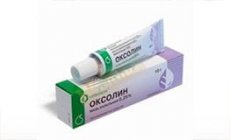Medical expert of the article
New publications
Preparations
Oxolin ointment
Last reviewed: 03.07.2025

All iLive content is medically reviewed or fact checked to ensure as much factual accuracy as possible.
We have strict sourcing guidelines and only link to reputable media sites, academic research institutions and, whenever possible, medically peer reviewed studies. Note that the numbers in parentheses ([1], [2], etc.) are clickable links to these studies.
If you feel that any of our content is inaccurate, out-of-date, or otherwise questionable, please select it and press Ctrl + Enter.

Oxolinic ointment is an antimicrobial and antiviral drug, a medicine for the treatment of dermatological pathologies.
Oxolinic ointment is available without a prescription. Consultation with a doctor is required.
Indications Oxolin ointment
Oxolinic ointment can be used to treat the following painful conditions:
- infectious and viral ophthalmological lesions;
- dermatological viral infection;
- rhinitis of viral etiology;
- shingles and herpes zoster;
- benign growths in the form of warts;
- herpetic cutaneous inflammation of Duhring;
- molluscum contagiosum virus;
- psoriatic rash - scaly lichen.
The ointment can also be used to treat the nasal mucosa as a preventative measure against influenza and acute respiratory viral infections.
 [ 1 ]
[ 1 ]
Release form
The drug is produced in the form of 0.25% or 0.3% ointment, in a tube, in a cardboard package, 10 g or 30 g, respectively.
The medicine has a white or soft yellow tint, but as a normal variant, a pink tint may appear during long-term storage.
1 g of the preparation contains:
- active ingredient – oxoline 2.5 or 3 mg;
- additional ingredients – Vaseline or Vaseline oil.
Used locally.
Pharmacodynamics
The medicine based on oxolin has antiviral activity against DNA and RNA viruses. These viruses include:
- adenoviral infection;
- influenza virus;
- herpes infection;
- Herpes Zoster.
The essence of the antiviral ability of Oxolinic ointment is explained by the chemical interaction of guanine products of viral nucleic acids - as a result of such interaction, the nucleic acid loses its functional properties.
 [ 2 ]
[ 2 ]
Pharmacokinetics
Since Oxolinic ointment is a drug for external use only, the pharmacokinetic properties of the drug have not been given sufficient attention. It is known that after the distribution of the drug on the skin and mucous membranes, the active component oxolin is absorbed fairly quickly, penetrates into the systemic bloodstream in small quantities and in insignificant quantities into the parenchymatous tissue of the liver, kidneys, and spleen.
The active ingredient quickly leaves the body completely through the urinary system, without accumulating inside the body.
Dosing and administration
Oxolinic ointment is used only locally:
- for therapeutic purposes in case of adenovirus infection (keratitis, conjunctivitis) – 0.25% medicine is placed behind the eyelid up to 3 times a day;
- in the treatment of rhinitis of viral origin, 0.25% of the medicine is applied to the mucous membranes of the nasal cavity up to 3 times a day for 4-5 days;
- as a preventive measure during flu epidemics and acute respiratory viral infections, as well as during contact with a patient with influenza, the ointment is applied to the mucous membranes of the nasal cavity, 2-3 times a day (usually in the morning and at night), for a month;
- For the treatment of simple, vesicular or herpes zoster, dermatitis and molluscum contagiosum, apply 3% ointment to clean skin up to 3 times a day. Duration of treatment is from 14 days to 2 months.
Use Oxolin ointment during pregnancy
Due to the fact that the pharmacological properties of Oxolinic ointment have not been sufficiently studied, this drug cannot be recommended for use during pregnancy and breastfeeding. There is no information on the safety or danger of the external drug during these periods.
If you believe that using the drug is unavoidable, it is recommended that you consult your doctor.
Contraindications
There are few contraindications to using the ointment, however, you need to know about them:
- tendency to allergic reaction to oxoline or petroleum jelly;
- periods of pregnancy and breastfeeding;
- childhood (there is not enough information on the use of the drug in pediatrics).
 [ 6 ]
[ 6 ]
Side effects Oxolin ointment
Side effects from regular use of the ointment may include:
- short-term burning sensation when applied to mucous membranes;
- superficial dermatitis;
- staining of the skin with a bluish tint (easily washed off);
- the appearance of thin, watery discharge from the nose.
All of the listed symptoms go away on their own after discontinuing the medication, which does not require additional treatment.
Overdose
There is no information on systemic overdose of the ointment for external use. Theoretically, it is possible to assume an increase in the severity of side effects.
Treatment consists of discontinuing the use of Oxolinic ointment. The areas where the ointment has already been applied should be washed with warm running water.
Interactions with other drugs
At the moment, there is no information about the interactions of Oxolinic ointment and other drugs. When using several external agents at the same time, consult your doctor.
 [ 11 ]
[ 11 ]
Shelf life
If stored properly, the product can be used for 2 years. The exact date of production of the ointment is indicated on the packaging.
 [ 14 ]
[ 14 ]
Attention!
To simplify the perception of information, this instruction for use of the drug "Oxolin ointment" translated and presented in a special form on the basis of the official instructions for medical use of the drug. Before use read the annotation that came directly to medicines.
Description provided for informational purposes and is not a guide to self-healing. The need for this drug, the purpose of the treatment regimen, methods and dose of the drug is determined solely by the attending physician. Self-medication is dangerous for your health.

